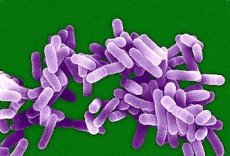Medical expert of the article
New publications
Legionellae
Last reviewed: 06.07.2025

All iLive content is medically reviewed or fact checked to ensure as much factual accuracy as possible.
We have strict sourcing guidelines and only link to reputable media sites, academic research institutions and, whenever possible, medically peer reviewed studies. Note that the numbers in parentheses ([1], [2], etc.) are clickable links to these studies.
If you feel that any of our content is inaccurate, out-of-date, or otherwise questionable, please select it and press Ctrl + Enter.

Currently, more than 50 species of legionella are known, and 22 species have been shown to play a role in human pathology. 95% of cases of the disease are associated with the type L. pneumophila. Its name is associated with the first victims of the disease caused by it among the participants of the American Legion congress, which took place in Philadelphia in the summer of 1976. In 1977, the pathogen was isolated from the lungs of the deceased by D. McDaid and S. Shapard.
Cultural properties of Legionella
Aerobes. These bacteria reproduce only on complex nutrient media (buffer-carbon yeast agar) with the obligatory addition of cysteine, iron pyrophosphate and ketoglutaric acid due to the need for these substances. Cultivation is carried out at 35 °C in an atmosphere of 2.5-3% CO; for 3-6 days. Colonies grown on a nutrient medium have an ingrown center with the formation of a brown pigment, with the exception of the species L. micdadei. They can be cultivated in the yolk sac of a chicken embryo and cell cultures, in the body of a guinea pig.
Biochemical properties of Legionella
Catalase-positive. Do not ferment carbohydrates, do not produce urease, do not reduce nitrates. Some species liquefy gelatin. L. pneumophila differs from other species of legionella in its ability to hydrolyze sodium hippurate.
 [ 8 ], [ 9 ], [ 10 ], [ 11 ], [ 12 ]
[ 8 ], [ 9 ], [ 10 ], [ 11 ], [ 12 ]
Antigenic structure of legionella
Complex. The L. pneumophila species is divided into 16 serogroups, the specificity of which is mediated by the lipopolysaccharide antigen.
Legionella resistance
Like other non-spore-forming bacteria, they are sensitive to UV rays, ethyl alcohol, phenol, and 3% chloramine solution.
Legionella pathogenicity factors
Legionella are facultative intracellular parasites. In the human body, they reproduce mainly in alveolar macrophages, into which they enter as a result of inhalation of microbial aerosol, as well as in polymorphonuclear and monocytes of the blood. Legionella actively reproduce in macrophages, which leads to the destruction of the latter and the release of a large number of bacteria into the lung tissue. This process is ensured by the following pathogenicity factors: cytotoxin and superoxide dismutase, which suppress the respiratory burst of the phagocyte; cytolysin, which is a metalloprotease enzyme that prevents the formation of phagolysosomes and also causes a hemorrhagic effect: when bacteria die, endotoxin is released, causing intoxication.
The repeated cycle of interaction between legionella and lung macrophages leads to the accumulation of the pathogen in high concentrations and the development of an acute inflammatory process.
Immunity
Cellular immunity. Antibodies do not have protective activity.
Epidemiology of legionellosis
In natural conditions, legionella live in freshwater bodies of water, where they are symbionts of algae, aquatic and soil amoebae and other protozoa. The high adaptive abilities of legionella allow them to successfully colonize artificial reservoirs, water supply and air conditioning systems, and medical equipment. On synthetic and rubber surfaces of plumbing, industrial and medical equipment, legionella form a biofilm, in which they become more resistant to the action of disinfectants.
The mechanism of transmission of legionella infection is aspiration. The main transmission factor is a fine aerosol containing legionella, formed by household, medical or industrial water systems. The disease is not transmitted from person to person. The disease is widespread. Including in Russia. The peak incidence occurs in the summer months. A predisposing factor is an immunodeficiency state.
Symptoms of Legionellosis
There are three known clinical forms of legionellosis: Legionnaires' disease (Philadelphia fever) and Pontiac fever, Fort Bragg fever.
The incubation period of Legionnaires' disease is 2-10 days. The disease is accompanied by fever, chills, chest pain, and shortness of breath. Acute respiratory failure develops in 20-30% of cases. Infectious toxic shock, renal failure, and damage to the central nervous system may develop. Mortality is 8-25%, and 60% in patients with immunodeficiency.
Pontiac fever is an acute respiratory disease without pneumonia. The incubation period is 36-48 hours. The disease is characterized by a 1-2-day fever, catarrhal symptoms in the nasopharynx, and a dry cough. No fatal outcomes are recorded. The disease affects 95-100% of people in the aerosol distribution zone.
Fort Bragh fever is an acute febrile illness with exanthema. The risk of nosocomial legionellosis is associated with the possibility of contamination with legionella of water supply systems, air conditioning, and medical equipment, as well as the presence of individuals susceptible to infection with impaired cellular immunity. In addition to L. pneumophila, nosocomial lower respiratory tract infection is caused by L. micdadei.
Diagnosis of legionellosis
Laboratory diagnostics of legionellosis is carried out using bacteriological, serological and rapid methods.
The material for isolating legionella is sputum, bronchoscopy material, pleural exudate, and lung biopsy material, which is stored for no more than 1 day at 4 C.
Serological testing is carried out by determining a 4-fold increase in antibody titer in paired sera using the ELISA or indirect RIF method.
Also, the determination of soluble antigen in urine is carried out on the 2nd-10th day using ELISA or immunochromatographic method.
Direct RIF and PCR are used as express diagnostics. However, a specific reliable result is obtained only if the material for the study is bronchoscopy and biopsy materials, and not sputum.
Prevention of legionellosis
Legionellosis cannot be prevented by specific prevention methods. Non-specific prevention of legionellosis comes down to periodic cleaning of water systems, identification of the water reservoir of the pathogen and its improvement.

